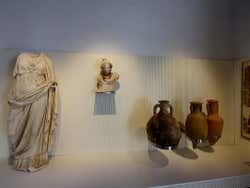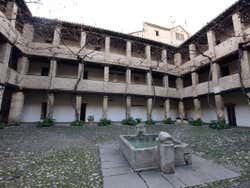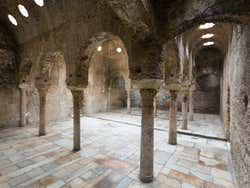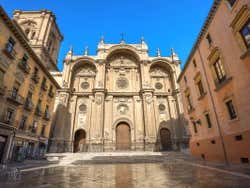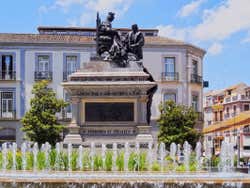
History of Granada
The origin of the name Granada dates back to the 11th century when the Zirids moved the capital of their kingdom from Medina Elvira to Medina Garnata. The origin of this new name could come from Latin, referring to the fruit of the pomegranate granatum, or from the Arabic gar-anat, "city of pilgrims".
Foundation of Granada
The first recorded settlement in Granada was that of the Iberians in the 7th century BC.
In 180 BC, Roman troops conquered the area, renamed it Iliberis, and had it recognized as a territory by Emperor Caesar. After several centuries of Roman domination, the Visigoths took control of the city in the 5th century, gaining both civil and military importance. As a consequence of the continuous growth of the population, numerous constructions were erected and a wall was built.
However, this defensive wall failed to stop the Amazigh troops that crossed the Strait of Gibraltar in 711 and invaded the Iberian Peninsula. Already under Muslim rule, Granada was renamed Ilbira or Elvira.
Middle Ages and the Zirid Kingdom
Between the 8th and 11th centuries, Cordoba became very prominent worldwide, outshining neighboring regions such as Granada. From the creation of the Emirate of Cordoba until the dissolution of the Caliphate, the territory that Granada occupied was largely uninhabited.
The Omeyan noblemen decided to revolt against the Caliphate during an attack on the Christian kingdoms in the north and that put an end to the Caliphate of Cordoba, giving rise to the first Taifa kingdoms. From this moment on, Granada was ruled by a North African family: the Zirids. The founder of this new dynasty in Granada was Zawi ben Ziri.
During the ninety years of Zirid rule, part of the old wall of Granada was built and the Al Qasbah Qadima was erected in the Albaicin. One of its towers remains standing to this day.
In 1090, new uprisings gave way to the second Taifa kingdoms and the city came under the control of the Almoravids, who built the Bermejas Towers and the Puerta de las Pesas. The Almohads wrested power from them in 1154 and also left their mark on the city by walling off the land that today houses the Realejo neighborhood.
Finally, in 1238, the troops of Muhammad Ibn al Ahmar conquered the city and the history of Granada entered its Nasrid stage.
Nazari Kingdom of Granada
The new Nasrid kingdom (1238-1492) extended over Granada, Almeria, Malaga and Cadiz. Due to the payment of tribute and its strategic geographical location, protected by the Sierra Nevada and connected by sea with the Maghreb, the kingdom of Granada succeeded in maintaining peace with the Christian kingdoms of the peninsula.
This small emirate became important as a trading hub and welcomed Muslims fleeing from the territories conquered by the Christians. During this period of magnificence, Granada's most important monument was erected and a living reflection of the Nasrids' passage through the city: the Alhambra.
King Alhamar began its construction and it was not until the middle of the 14th century that the Alhambra finally got the appearance it has today, divided into the citadel, the urban network that surrounds it, and the palaces.
During the more than two centuries of Nasrid domination, the kingdom of Granada experienced a period of unprecedented cultural and artistic magnificence, with a strong Islamic culture that has remained latent in many of its monuments.
However, conflicts with the Christians became increasingly intense, and political instability became more prominent.
The War of Granada and the end of the Catholic Conquest
At the end of the 15th century, the Nasrid kingdom of Granada was the Al Andalus stronghold left standing on the Iberian Peninsula. For 250 years, the twenty monarchs of this emirate had managed to keep the neighboring Christian kingdoms at bay through trade agreements and tribute payments.
But after the union of the crowns of Castile and Aragon in 1474, the pressure of the Christian kingdoms on the kingdom of Granada became almost unbearable and the troops of the Catholic Monarchs surrounded the city.
This military conflict lasted for ten years, during which the kingdom of Granada lost most of its trading and economic power and was left at the mercy of its adversaries. The Christian troops besieged the city until Boabdil, the last Nasrid king, signed the Capitulations of Granada on November 25, 1491, and handed over the keys of the city to the Catholic Monarchs.
On January 2, 1492, the Christian troops entered the city in the famous capture of Granada and the Iberian Peninsula was completely under Christian rule.
Although the capitulations included freedom of worship and respect for all religions, the reality was very different. A few months after the conquest of the city, Muslims and Jews were forced to convert to Christianity. Many left the peninsula and others became Moriscos or converts.
From then on, the kingdom of Granada was consecrated as an important Christian center until the territorial organization by provinces in 1833.
Granada in the Modern and Contemporary Ages
One of the most important moments in the history of Granada that marked the beginning of the Modern Age was the meeting between Christopher Columbus and the Catholic Monarchs. On April 17, 1492, the Capitulations of Santa Fe were signed, a document that reflects the agreement reached between the monarchs and the Genoese admiral to finance a journey to the Indies.
In the 15th and 16th centuries, a process of "Castilianization" of Granada was carried out. The mosques were demolished and new churches and buildings as representative as the Royal Chapel, the Cathedral and the Palace of Charles V were built.
Over the following centuries, the city was filled with Baroque art. However, the demographic drain took hold of the city and Granada became less important on the national scene during the 18th and 19th centuries.
In the 20th century, important artists such as Federico García Lorca and Manuel de Falla captured the authentic beauty of Granada in their pieces.
History of Granada in the 21st century
-
In recent years, Granada has become the university city of southern Spain, with over 80,000 students from Spain and other countries. The indie nature of Granada has charmed not only young visitors but also the older ones.
Granada is the seat of the High Court of Justice of Andalusia, Ceuta, and Melilla, as well as the regional library, the Musical Documentation Center of Andalusia, and other institutions.
Its city coat of arms preserves the title of "very noble, very loyal, renowned, great, celebrated and heroic city of Granada".
